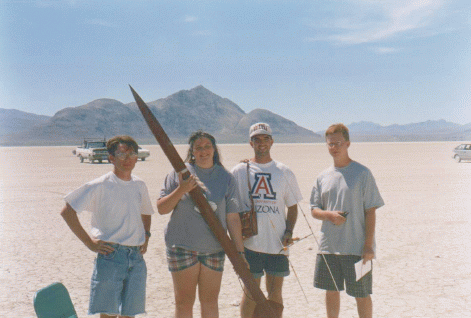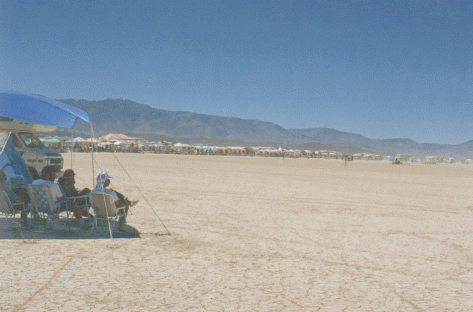

After almost two years of drawings, simultaneous, and government regulatory hassles, the SEDS rocket project flew the largest rocket ever launched by a non-professional group at the University of Arizona. The two meter long fiberglass rocket flew better than expected, particularly in the areas of boost stability and overall performance. The rocket, known casually as "Act of God," was flown at the Tripoli High Powered Rocket Association's annual convention in Gerlach, Nevada, this August 12, 1995. This launch, know by the initials LDRS, or Large Dangerous Rocket Ships, is the one launch a year where the largest high performance rockets can be flown legally and safely in the wide open spaces of the Black Rock dry lake bed. The SEDS rocket team piled essential equipment, the rocket and custom launch tower (thanks to Phil Cojanis, for machining the tower), camping gear, and five SEDS members (Chris Lewicki, Ric Zaller, John Brownlee, Chris Greene, and Jasmine Pandolfo) in a vehicle and headed out.
After a cramped, crazed, non-stop, 20-hour-long drive to the launch, the SEDS camp was established, on the south side of the range and, it turned out, upwind of the flying rockets most of the weekend. But even after the months of construction and preparation, there were still almost two days of preparations left to ready the electronics payload and recovery systems for the flight.
Ric Zaller designed and built the SEDS electronics payload over the last 18 months, which included two redundant pressure sensors, a temperature sensor, and a hard-disconnect sensor for the payload/booster separation event at T+40 seconds into the flight. A recovery beacon and receiver borrowed from the Fish and Wildlife department at the University was used to track the rocket.
The rocket itself was designed by John Brownlee, and extensively modeled on a PC. It was constructed from spiral-wound fiberglass stock by John Brownlee, Chris Lewicki, and Roger Tanner. The rocket was predicted to reach an altitude of 17,000 feet above ground level (AGL), and a speed near Mach 1.00. The rocket booster section carried an Aerotech K250 motor, with a peak thrust of 110 pounds, and a burn time of just over 10 seconds. A pyrotechnic delay train was used because electronic recovery triggers were not ready in time for this launch. Special thanks to Jim McLaughlin of Portland Tripoli for helping us get the motor in time for the launch.

The launch stand ready, and the rocket armed, the group fell back to the firing control to watch the launch from the minimum safe distance of 1000 feet from the pad. The countdown went smoothly, and then the launch circuit closed. The flight was amazing straight-arrow, morose than anyone else's that day, in tribute to a good aerodynamic design in the gusty winds. Many launch veterans commented on how surprised they were that a high performance rocket could be so stable in flight, particularly near the sound barrier. The motor was much more powerful than anyone could have predicted, lifting the rocket near cloudbase, or approximately 10,500 feet on that particular day.
Lost in the clouds, however, optical tracking was lost, and everybody craned their necks to find any sign of the rocket coming down. A small audible pop was heard near burnout time, now thought to be a premature ejection of the payload section and drogue chute bag near burnout. This was due to a faulty pyrotechnic delay train installed improperly by the manufacturer of the motor.
Nearly a dozen spectators tried to locate any sign of the deployed parachute, or a ballistic rocket coming down at a terminal velocity of several hundred miles per hour. And, just as the recovery beacon seemed lost, Ric Zaller, with binoculars in hand, called out, "I see it."
After nearly 17 minutes of drift time, Ric and Chris Lewicki shot compass bearings to the estimated touchdown point, and everyone hopped in the 4X4 and rode off to a high speed into the lakebed to find the rocket. The drift time was too long for a proper recovery system deploy, which we now know was due to a cut safety line as the rocket sections separated at over 400 MPH. However, Jasmine, who tracked the payload beacon from the camp, was confident that we were heading in the right direction.
The parachute was still open when the payload section, undamaged in any visible way, was located, being pulled across the slick dry mud by a billowing parachute. The boost section, secured by both elastic line and kevlar backup, was torn cleanly in half from the booster section, and Ric began preparing the electronics to off-load the flight data.

Upon return to the camp, the booster section was found in the "graveyard," or the roped off area to deposit other rockets found while looking for your own. A small spiral stress fracture was visible, no doubt yielding due to a fall from over 10,000 feet. One fin was noticeably cracked at the root, and the conical boat-tail at the bottom was nearly popped off, but as per the design, all breaks were at joints, and no broken parts were caused in the fall. Repairs are underway, and should be completed shortly.
There was one last disappointment for the afternoon. A glitch in the electronics triggering caused data logging to be begin on the launch pad while waiting for launch, not during flight. The record was full of surface-level data, and contained no hard-separation data or altitudes. However, it should be noted that the electronics were not to blame in particular, and that a better method of triggering the flight recorder is being designed.
And so, as the five tired, dusty rocketeers pulled into Reno for a hot shower (the first in almost 5 days), and a decent meal, there was little disappointment. LDRS had been an incredible launch for SEDS, and all in all an excellent first test of our rocket hardware. Over dinner that night, there was already talk of what SEDS was going to do next year for the Nevada summer launch. Two stages? Hybrid motors? Live video broadcasts from the payload section?
No one knows yet. But, if you want to be a part of that decision, and many others dealing with rocket construction here at the UofA, please send e-mail to John Brownlee (jonnie@seds.lpl.arizona.edu). There's space for everyone, and all majors are welcome. - John Brownlee
 |